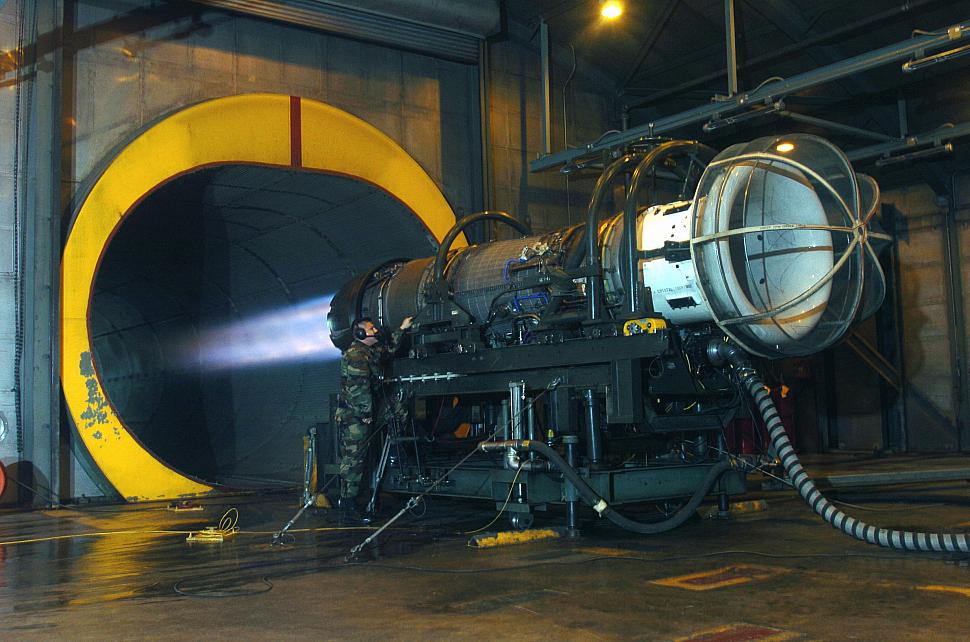Fighter Jet News
F-16 Fighting Falcon News
Test cell maintainers keep aircraft engines revving
August 25, 2004 (by
MSgt. Val Gempis) -
Straddling an F-16 Fighting Falcon engine that is producing 30,000 pounds of thrust as it furiously roars full blast during testing is not for the faint hearted. The ground shakes as the engine shoots 30-foot flames out the exhaust with a deafening noise, and the strong winds can knock someone to the ground.
But aircraft engine propulsion technicians at the 51st Maintenance Squadron at Osan AB, South Korea, said working at the engine test cell facility is the best and most exciting job in the Air Force.
"I love it here," said Staff Sgt. Daniel Guerra. "What I do gives me a sense of accomplishment."
The test cell Airmen ensure that F-16 engines are ready and in top condition because the aircraft can be called upon to fight at anytime.
"Our job is very important," said Tech. Sgt. Brian Jett, section chief. "It saves lives and money."
The three-person team tests, monitors and analyzes the health of an engine while it is mounted on a stand inside the hangar facility. The Airmen measure engine pressure, vibration, thrust, temperature, fuel and airflow problems. These "runs" provide them critical information on the durability and condition of the engines.
They said test durations vary; some are as short as 20 minutes, and others can last as long as two hours.
Before the inspection starts, the cylindrical engine is wired electronically. During operations, two Airmen check the readouts from gauges inside a cab while the other visually inspects the engine for cracks, leaks or unsecured cables and wirings. They communicate with each other using head phones.
Engine failure or an accident can happen if they overlook even minor discrepancies, Sergeant Jett said. It can cost the Air Force millions of dollars, or the life of a pilot.
Every day, the Airmen check every nook and cranny in their building. They ensure equipment is secured or properly locked in place. The mechanics make sure every bolt and screw in the building is tight, because during testing, the engines rattle the facility.
"Little objects can do a lot of damage if (they get) sucked inside the engine," said Staff Sgt. Douglas Hubbard.
Testing the engines is something new for many of the mechanics.
"Seeing the engine's full capability instead of just tearing it apart and building it again has been a great experience for me," Sergeant Guerra said.
The Airmen said they are proud to be an integral part of the mission here every time they see the jets take off.
"There's no thrust without us," Sergeant Guerra said.
"I love it here," said Staff Sgt. Daniel Guerra. "What I do gives me a sense of accomplishment."
The test cell Airmen ensure that F-16 engines are ready and in top condition because the aircraft can be called upon to fight at anytime.
"Our job is very important," said Tech. Sgt. Brian Jett, section chief. "It saves lives and money."
The three-person team tests, monitors and analyzes the health of an engine while it is mounted on a stand inside the hangar facility. The Airmen measure engine pressure, vibration, thrust, temperature, fuel and airflow problems. These "runs" provide them critical information on the durability and condition of the engines.
They said test durations vary; some are as short as 20 minutes, and others can last as long as two hours.
Before the inspection starts, the cylindrical engine is wired electronically. During operations, two Airmen check the readouts from gauges inside a cab while the other visually inspects the engine for cracks, leaks or unsecured cables and wirings. They communicate with each other using head phones.
Engine failure or an accident can happen if they overlook even minor discrepancies, Sergeant Jett said. It can cost the Air Force millions of dollars, or the life of a pilot.
Every day, the Airmen check every nook and cranny in their building. They ensure equipment is secured or properly locked in place. The mechanics make sure every bolt and screw in the building is tight, because during testing, the engines rattle the facility.
"Little objects can do a lot of damage if (they get) sucked inside the engine," said Staff Sgt. Douglas Hubbard.
Testing the engines is something new for many of the mechanics.
"Seeing the engine's full capability instead of just tearing it apart and building it again has been a great experience for me," Sergeant Guerra said.
The Airmen said they are proud to be an integral part of the mission here every time they see the jets take off.
"There's no thrust without us," Sergeant Guerra said.
Courtesy of Air Force Print News
Additional images:


Staff Sgt. Daniel Guerra looks for fuel leaks and cracks while an F-16 Fighting Falcon engine "runs" full blast at the test cell facility at Osan AB. Engine runs ensure that they are in top condition after repairs. Sergeant Guerra is an engine propulsion mechanic assigned to the 51st Maintenance Squadron. [U.S. Air Force photo by Master Sgt. Val Gempis
]
Related articles:
Tags
Tags

